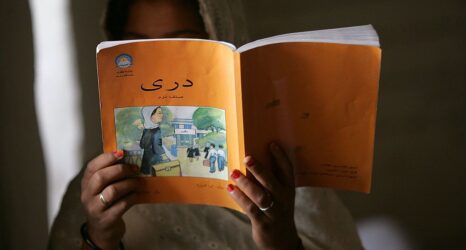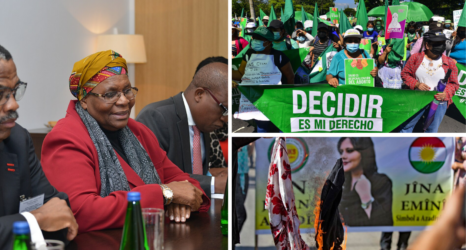A woman receiving a shot of the contraceptive Depo Provera at Shinshicho Health Center in Ethiopia. Photo courtesy of Population Action International.
In Daka Werekelo, Roba estimates that 120 out of more than 500 women of childbearing age now use birth control—and that’s remarkable. “Previously no one was using it due to religious factors,” she explains (like the majority of those in her village, she is Muslim). “But it is increasing. We are happy when women listen and there is progress.”
HEWs learn to deliver babies during their pre-service training year, but officials would prefer women give birth at health centers—the next level up from the village-centered health posts where HEWs work. In the face of serious complications, a woman could be taken from there to a hospital.
Unfortunately, the health centers lack resources as well. The Shinshicho Health Center located in a rural area of southern Ethiopia, for example, has one doctor and 12 nurses to serve more than 57,800 people. The nearest hospital is 12 miles away and the center has no ambulance. Last summer, four men hauled a very sick woman to the center on a homemade stretcher; the trip took two hours. In another case, a mother brought in her school-age son, who had been sick for months, on a rickety donkey cart. She had traveled 12.5 miles.
Ethiopia has a shortage of medical providers that even the HEWs can’t alleviate. There is an average of only 1.5 physicians for every 50,000 people. In contrast, the U.S. has approximately 120 doctors for every 50,000.
Dr. Dereje Alemayehu, medical director at Gandhi Memorial Hospital, a public maternity facility in Addis Ababa, says many doctors in his medical school class left the country. “I have a friend in Minnesota, another in Washington and also in Australia,” he says. “For financial reasons, people get their certificates and they leave.”
“You see more Ethiopian doctors in the U.S. than in their own country,” adds Dr. Mengistu Asnake, deputy country representative in Ethiopia of Pathfinder International, an organization that focuses on reproductive health.
In the cold face of such realities, can the ambitious experiment of deploying 30,000 young women into villages to provide bare-bones basic health care and education turn things around? The Ethiopian government insists that by relying primarily on the each-one, teach-one work of the HEWs, it can meet at least one crucial deadline: the U.N.’s health-related Millennium Development Goals, which include reducing the under-5 mortality rate by two-thirds and the maternal mortality rate by three-fourths by 2015. Those were the standards set in 2000, and each country has come up with its own strategies for meeting them.
“If you look at our performance in the last five years in Ethiopia, being ambitious really works,” says Dr. Kesetebirhan Admasu Berhane, director general of health promotion and disease prevention for Ethiopia’s Federal Ministry of Health. He cited the outstanding progress the country has already made in maternal health, even before the HEP program: In the past 20 years, maternal deaths have dropped by nearly half. After the HEWs kicked into action, there was an additional 12 percent decrease.
Abby Maxman, the country director for CARE Ethiopia, sees the work of the HEWs as one of the country’s best hopes for long-term, sustainable transformation.
“While one has to balance the ambitiousness with the breadth and depth of the challenges,” says Maxman, “we also understand that when a woman is able to control, negotiate and have a voice and choice in managing her reproductive health, families are healthier and wealthier, and the benefits are enormous for the rest of the community.”
In Southern Ethiopia, along the rutted dirt road between the rural village of Galato and Halaba— the nearest town with a tap of clean running water—a constant stream of women lug 20-liter yellow jerricans of water back and forth, sometimes several times a day. The lucky ones have donkeys to share the load. From a distance, many rural Ethiopian roads look like a snaky sea of yellow.
Most mornings by 8 a.m. Amina Leriso, her belly swollen with her fifth child, has begun her several-hour journey from Galato to fetch water for her family. She lugs one 20-liter jerrican and a smaller, 5-liter container. Sometimes the water has already run out when she gets there and she simply walks home.
The lack of sanitary water is something HEWs often hear about and have to deal with in their practice, as inadequate sanitation can lead to numerous infectious and parasitic diseases, from diarrhea to cholera. Less than one-third of Ethiopia’s rural population has access to clean water within a kilometer of where they live. Last year, USAID spent $7.5 million for water and sanitation in Ethiopia, but those who work in the country agree that more is needed. “Water is clearly an important issue in a huge country with so many different needs,” says Staal of USAID. “We get a small earmark from Congress and would be happy to get more.”
Late last summer in Galato, when townspeople gathered under a shady tree for their twice monthly “community conversation,” water was on everyone’s mind. One farmer, Abdul Kadir Mohammed, spoke up: “We don’t have enough water. No water to drink, no water for sanitation. We understand how to clean ourselves and what to do to take care of ourselves, but we don’t have the water to do it.”
Yitayish Tsige, a 27-year-old HEW for the village, assured Mohammed that she would take his concerns to the district office, but he knew that might not help. Later, he said through an interpreter, “Every time anyone comes from the district, we always bring up this question, but we never get a response. That pond over there”—he pointed to a muddy pool of water the color of hot chocolate—“both cattle and people drink from it. This is a huge problem.”
But even in the face of these obstacles and more, HEWs still go about their remarkable efforts to educate, minister to people and save lives. They also have had an unpredicted effect on young girls. In a country where 75 percent of women are illiterate, HEWs must have completed 10th grade and be literate, and as such they’re looked up to as role models.
“We call these young women health extension workers, but they are really like doctors in the community,” says Adey Abebe, advocacy and communications manager for Pathfinder International in Ethiopia. “They have to know how to read and write and are the most educated people in most villages. They even tell the men what to do, which is very unusual in these mainly Muslim communities. They have huge challenges, but they are also changing a culture that’s been in place for centuries.”
Amina Leriso only finished fourth grade and married as a teenager, but hopes for more for her 17-year-old daughter, Neima. “My wish is for her to complete her education, get a respectable job and be independent,” she says, standing by the hearth in her home, where Yitayish Tsige has come to pay a visit.
Glancing over at Tsige, Neima agrees. “I have no plans to get married anytime soon,” says the teenager. “I want to be a doctor.”
Linda Villarosa is a journalist, editor and novelist in New York, with a strong background in health issues. She is director of the journalism program at the City College of New York, where she teaches writing and media studies. Her fact-finding trip to Ethiopia was sponsored by Population Action International.
Excerpted from the Winter 2011 issue of Ms. To have this issue delivered straight to your door, join the Ms. community.
Comments on this piece? We want to hear them! Send to letterstotheeditor@msmagazine.com. To have your letter considered for publication, please include your city and state.












